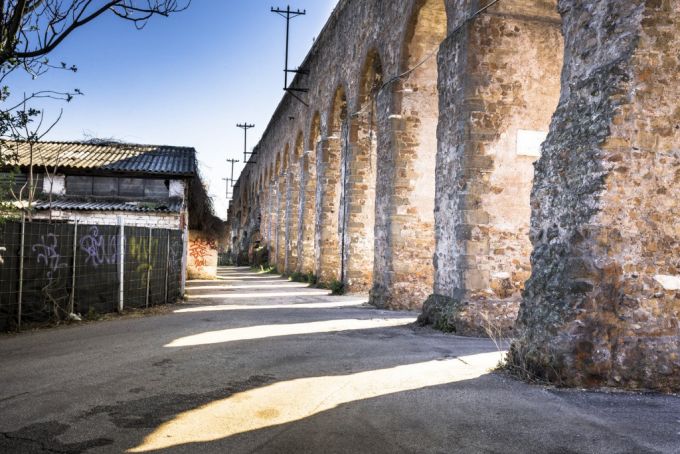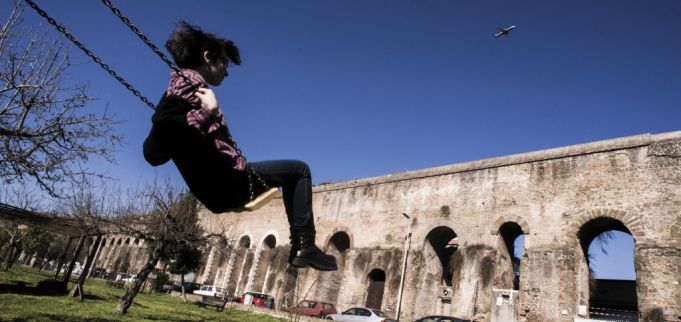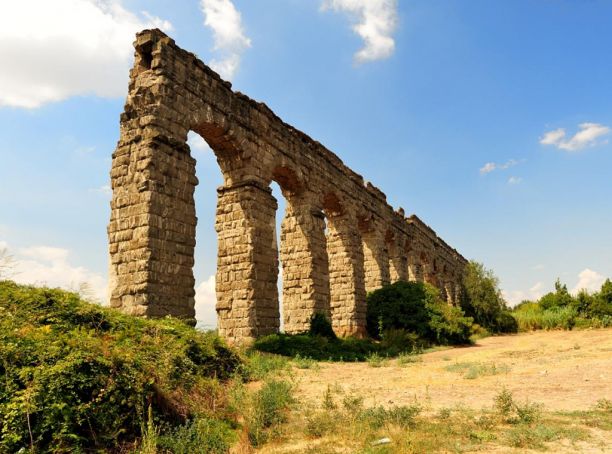Rome's ancient aqueducts
Altars of water: exploring the aqueducts of ancient Rome.
South of Giulio Agricola metro stop stretches one of Rome's best kept secrets – il Parco degli acquedotti – as majestic in its way as the Colosseum but hardly a tourist in sight and not associated with mass bloodshed. There across Rome's campagna the Aqua Claudia is still striding strong, in places two arches high.No wonder Frontinus, curator aquarum, dubbed it magnificentissimus. All the more so when measured against the Acqua Felice (after the 16th-century Pope Pius V, otherwise known as Felice Peretti) which runs parallel to it, a chunk of Acqua Marcia tacked on to the end.
This was the aqueduct that the barbarians sought to damage if not destroy. When they attacked Rome – then as now the most fountained of cities – one of their first acts of vandalism was to cut off the water supply. Within a matter of generations Rome, caput mundi, had dwindled to little more than a village, a waterless backwater.The barbarians – with subsequent help from floods and earthquakes – knocked Rome back to pre-Republican times when the only water source was the Tiber. As the proverb says, “You only know the worth of water once the well runs dry.”

In its imperial heyday, Rome’s 11 aqueducts – others being added later by various popes – delivered a million litres of the precious substance daily. One expert Romolo Staccioli observes how this is double today’s per capita supply, although Jerome Carcopino’s Daily Life in Ancient Rome questions to what extent the water arrived in single households: in the insulae, ancient equivalent to the apartment block, water was reserved for the ground floor.
Hence the existence of aquarii or water carriers to supply the tapless tenants above. The main use was collective rather than private – supplying fishponds, creating artificial lakes for mock sea-fights, watering the public baths and, by 300 AD, serving 1,300 public fountains.
Rome’s aqueducts can hold their own against the ancient world’s Seven Wonders. Ancient historian and engineer Frontinus rates them higher, commenting that the pyramids never helped anyone directly.Diogenes of Halicarnassus remarks that “Rome’s greatness rested on three wonderful achievements: aqueducts, roads, and the sewage system.” Pliny the Elder, witness to history par excellence, opines: “...of all things that have existed in the world, aqueducts are the most marvellous.” “A succession of triumphal arches,” Goethe would remark. John Ruskin, that great aficionado of stone, speaks of “‘an endless row of weeping willows stretching out over the corpse of an empire.”
A more modern metaphor might be that of a train, especially as you race alongside on the line to Naples. Predating Stephenson or Brunel, come marsh or mountain, here in long-standing stone is a locomotive that was never late – less blot on the landscape than ornament, conserving energy at a perfect tilt. To quote an engineering friend, “The Pont du Gard has a museum; why not Rome’s aqueducts?”Dating to 311 BC Rome's first aqueduct, Aqua Appia, is named after Appius Claudius Caecus who “opened Via Appia and brought water to the city,” to cite an engraving in the forum of Augustus. The next aqueduct – the wending and likewise almost totally subterranean Anio Vetus – came 40 years later. What’s more, the senate appointed two magistrates to manage it, the so-called duumviri aquae perducundae. Nobody can accuse the Romans of not taking water seriously.
One problem, though, was that the water was on the muddy side, another that, as with today’s oil-pipelines or electricity cables, some citizens would tap into the system illegally. Over the centuries the water supply halved.To compensate for the lack (also exacerbated by a rising population) in 144 BC a third aqueduct – Aqua Marcia – was built at an astronomical cost of 180,000,000 sestertii by praetor Quintus Marcius Rex. Pliny dubbed its water “a gift of the gods” for its purity and freshness, the ideal additive to the rather rough wine of the period. Fourth comes Aqua Tepula (126 BC), as in tepid, it being warmed by Colli Albani’s volcanic rocks while also sharing arches in places with its immediate predecessor.

To each aqueduct its presiding genius: up there with Appius as an all-time engineering great is Marcus Agrippa (of Pantheon fame). His role of aedile, which included administering Rome's many bath complexes, impelled him to build not one aqueduct but two: Aqua Julia (33 BC) and Aqua Virgo (19 BC).
Bread and circuses are one sine qua non whereby the empire might rise or fall; water is another. “When the people complained about the high price of wine,” writes Suetonius, “Augustus reproved them, his son-in-law Agrippa having ensured nobody should go thirsty.”According to Carcopino, Agrippa marked his term of office by making entrance to the baths free for the year of his aedilship. Formerly supplying the Terme di Agrippa near the Pantheon, Aqua Virgo, albeit with some Renaissance restoration, supplies the Trevi Fountain to this day. Still operative, its tunnels form an ecosystem complete with white water snakes and less ecologically-friendly traces of radon, a result maybe of the water’s tufa origins.
The Aqua Alsietina (built around 2 BC and sometimes called the Aqua Augusta, but not to be confused with the aqueduct of the same name in Naples) – named after the Latin for Lake Martignano, which supplied the basin for spectacular naval battles (naumachiae) in Trastevere. Less well known, it’s also entirely underground. Still functioning in the third century AD, it then dried up when the water levels in the mother lake dropped.Next up, in the grandest sense of the preposition, is Aqua Claudia (38 AD), started under Caligula and finished under Claudius about 14 years later. Take Termini’s yellow-and-white trenino to Villini, and across the tracks there it runs to your right, topped with now ivy, now new-fangled electronics. Slip down Via del Mandrione: beyond the snug tunnel, in Via Casilina Vecchia the aqueduct gets close and personal.
The arches form an entrance to distinctly non-monumental modern homes. By contrast, Aqua Traiana (to supply Trastevere) has shrunk to an image on a 103 AD coin: A river god reclines under one of its arches, a reed in one arm and under the other water gushing from a pot. It was later rebuilt under Pope Paul V and renamed Aqua Paola, and still feeds the famous Aqua Paola fountain on the Janiculum.
Finally comes Aqua Alexandrina in 226 AD, named after Emperor Alexandrus Severus. Architectural advances meant it could be built mostly above ground. Built and how! History lecturer Romolo Staccoli has its arches counted: 34 at Fosse di Torre Angela, 140 at Centocelle, 52 at Torpignattara where in the summer local Bangladeshis play cricket in their shadow.At Porta Maggiore it meets Anio Vetus and Anio Novo (52 AD), Aqua Appia, Aqua Marcia and, commemorated with a giant plaque, Aqua Claudia, the big daddy of them all. Add flyovers, power-lines, tram-tracks, railways for the ultimate historical palimpsest.
All roads lead to Rome; here the same may almost be said of aqueducts, all that stonework echoing another thought best expressed by W.H. Auden: “Thousands have lived without love, not one without water.”
By Martin Bennett
SIDE NOTES
Aqueducts in order of construction
1. Aqua Appia 311 BC2. Anio Vetus 271 BC
3. Aqua Marcia 144 BC
4. Aqua Tepula 125 BC
5. Aqua Julia 33 BC
6. Aqua Virgo 19 BC
7. Aqua Alsietina 2 BC
8. Aqua Claudia 52 AD
9. Anio Novo 52 AD
10. Aqua Traiana 109 AD
11. Aqua Alexandra 226 AD
This article was published in the 2 April 2014 edition of Wanted in Rome magazine.





















